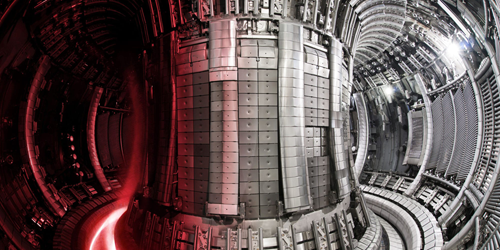Measuring Fusion Power
An equal mix of deuterium (hydrogen-2) and tritium (hydrogen-3) is the optimal fuel for most tokamaks and other fusion reactors that confine burning plasma with magnetic fields. Right after the two hydrogen isotopes fuse, the resulting helium-5 nucleus decays into helium-4 and a free 14-MeV neutron. Besides being the reactor’s principal source of harvestable energy, the energetic neutrons also serve as a metric for the fusion rate and, with it, the reactor’s power output. Now two international teams of researchers have demonstrated that gamma rays produced in a rarer, subsidiary decay could provide an accurate and alternative metric [1, 2]. The teams, which share some of the same members, conducted their experiments at the Joint European Torus in the UK when the tokamak ran a series of test runs in 2021.
Tallying energetic neutrons produced in the principal fusion reaction might seem straightforward, but it’s fraught with practical difficulties. Neutrons are also produced by other processes, leading to high background rates, and their passage from the reactor chamber to an external detector requires intricate modeling and time-consuming calibration. By contrast, gamma rays, which are produced only in the rarer decays, are easier to detect, and their transport is easier to model.
In this rarer decay, the excited helium-5 nuclei are expected to shed energy by emitting successive gamma rays with energies of around 16 and 14 MeV. By measuring the gamma-ray spectrum in that energy range for the first time, one of the teams confirmed that the predicted rarer decay does indeed take place and assessed the relative yields of the two gamma rays [2]. Inferring the fusion rate from this gamma-ray emission requires knowing the branching ratio—the relative frequency of the gamma- and neutron-producing decays. The other team determined the ratio’s value—another first—by integrating the measured gamma-ray spectrum, measuring the flux of 14-MeV neutrons, and modeling the transport of gammas to and through the detector [1].
The gamma-ray detector the teams used is compact, which portends the routine use of gammas as a convenient way to measure the power of new fusion reactors, including ITER, which is under construction, and SPARC, which is expected to begin operations in 2025.
–Charles Day
Charles Day is a Senior Editor for Physics Magazine.
References
- A. Dal Molin et al., “Measurement of the gamma-ray-to-neutron branching ratio for the deuterium-tritium reaction in magnetic confinement fusion plasmas,” Phys. Rev. Lett. 133, 055102 (2024).
- M. Rebai et al., “First direct measurement of the spectrum emitted by the 3H(2H, 𝛾)5He reaction and assessment of the 𝛾1 and 𝛾0 relative yields,” Phys. Rev. C 110, 014625 (2024).




